Insect & Disease Conditions Update
May 29, 2019
In this issue:
May brings some personnel changes to our world that we’d like to share with you. On May 20th, we welcomed Bureau Director and State Forester, Patty Cormier, to her new role in the Forest Service.
We also celebrated the return to work of Patti Roberts, who provides administrative support and a whole lot more to the Division of Forest Health & Monitoring.
We are pleased to announce that Mike Parisio has accepted the forest entomologist position formerly held by Allison Kanoti, who moved into the role of State Entomologist and Director of the Forest Health and Monitoring Division in January. Mike will join us on May 30th—we’ll take the opportunity to introduce him in more detail in our next bulletin, by which time many of you will have had a chance to meet him in person.
We are sorry to see Greg Bjork leave the ranks of our Forest Inventory Unit—over the nearly 15 years with the program he has been a valued employee and has frequently assisted the Insect and Disease Management unit. We will miss his easy-going manner and willingness to tackle demanding work.
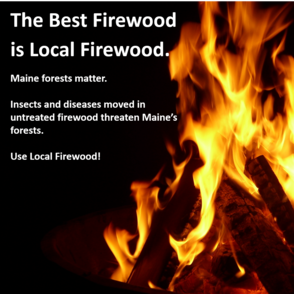
The beginning of a new season of outdoor recreation brings new focus to the dangers posed to our forests by invasive forest pests, often spread by infested firewood. Recreationists and camp owners need to be aware of the threats invasive forest pests pose to Maine’s natural resources. Of course, the discovery last year of emerald ash borer (EAB) in two areas within Maine adds even more urgency to this message.
It is still illegal to bring untreated firewood from out of state across Maine’s borders, even into areas that are quarantined for EAB. But with EAB located in the state, movement of firewood within the state becomes affected. It is now illegal to move untreated firewood from inside the EAB quarantined areas to areas outside the quarantines.
Even within the quarantined area, we ask people to consider how their actions can impact the movement of EAB and other forest threats. If you live in an area which is still free of EAB and have ash firewood from near an infested area, please try to burn it before May 1 when the risk of EAB adults emerging and flying starts to rise. And as always, we recommend burning firewood within 50 miles of where it was harvested. This reduces the chance of moving a yet-undiscovered pest long distances.
|
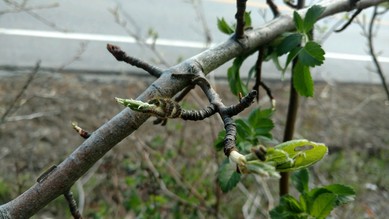
Browntail Moth (Euproctis chrysorrhoea) – Now is the time of the year that the caterpillars have begun to wander, so homeowners should be cautious around their property as caterpillars might be present on decks and the sides of houses. As the caterpillars mature, they will begin to wander. It is from this point through the end of the adult activity that you can most easily spread browntail moth to new areas. Caterpillars, pupae and adults can all travel with you, in or on your vehicle. We borrow the "look before you leave" message from our counterparts at the Pennsylvania Department of Agriculture Spotted Lanternfly Program and likewise urge you to check your person and vehicle for browntail moth before traveling. When possible, don't park near infested trees, learn to recognize the caterpillars and remove them if you find them. If you frequently travel between infested and uninfested areas, be on the lookout for signs you've taken this hitchhiker for a ride.
Photo: Browntail moth larvae feeding on an apple tree in Manchester.
Learn to recognize the signs of browntail moth infestation (webs are visible before leaf-out and after the tops of the trees are defoliated; defoliation starts at the tips of the branches and moves inward). More information about how to recognize browntail moth and where we know it occurs can be found on our website: www.maine.gov/forestpests#btm.
Although it has been a dreary and dismal spring so far weather wise, we’re in good shape for an outbreak of Entomophaga aulicae, the fungus that attacks browntail moth. If this weather streak keeps up through June, we’ll likely see some local population collapses.
In collaboration with UMaine’s Dr. Ellie Groden and Karla Boyd, we will be monitoring various browntail caterpillar populations into late June/early July to assess if there will be an outbreak of any of the pathogens that attack browntail moth; we are eager to see the results. The caterpillars have been somewhat delayed this year due to the cooler wet weather. We’ve seen some caterpillars feeding, however most are still clinging/basking on their nests waiting for slightly warmer weather and for more foliage to unfurl.
|
Eastern Tent Caterpillar (Malacosoma americanum) vs Browntail Moth (Euproctis chrysorrhoea)
It’s a case of mistaken identity. Every season we receive calls from concerned citizens who mistake eastern tent caterpillar nests for browntail nests. Two key differences between the nests these species make is size and position on the tree. The silken nests of native eastern tent caterpillars start small but can grow quite large, reaching around the size of a football and are attached to the tree where the branches meet the trunk. Browntail winter webs are the size of your palm or smaller and are constructed in late summer/early fall on the tips of the branches and are comprised of silk that also incorporates the leaves on the branch tips. The photos show an eastern tent caterpillar nest to the left and a browntail moth winter web on the right (note, the eastern tent caterpillar nest will continue to enlarge as it develops through the spring and summer).
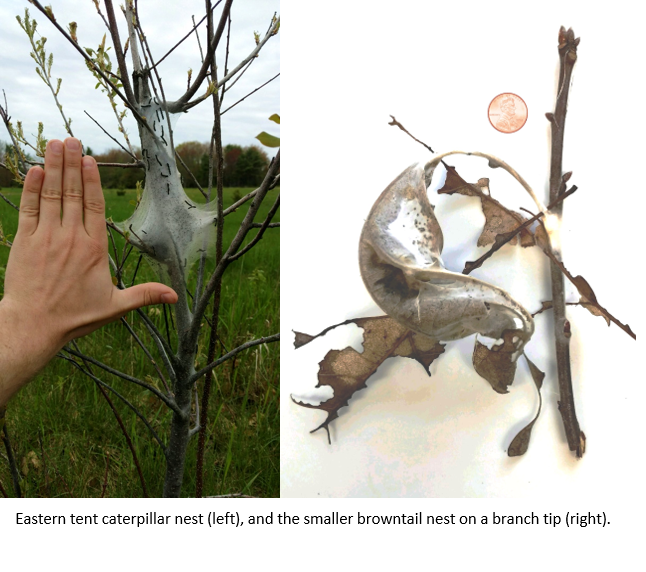

Emerald Ash Borer (Agrilus planipennis) – The Maine Forest Service (with the help of personnel from the Division of Animal and Plant Health, and some of the tribes) will be hanging a little over 200 purple prism traps over the next few weeks. They will be hung outside the quarantined areas to monitor of possible spread of emerald ash borer (EAB).
Photo: Girdling a trap tree with arborist, Tony Aman (courtesy photo).
Inside the quarantined areas, we will be using girdled trap trees to monitor EAB. If you are considering girdling a trap tree, now is the time to do it. To refresh your memory, emerald ash borer adults are attracted to stressed ash trees. In spring, an ash tree is ‘girdled’ (the bark peeled off all the way around the tree). Although this will eventually kill the tree, it stays alive throughout the following year. Girdling stresses the tree, causing it to release compounds into the air which make it attractive to local emerald ash borer (EAB). If there are any EAB present, they will tend to be attracted to this tree, rather than flying to random ash trees (This also helps protect nearby ash trees). EAB will lay their eggs in this tree, and the larvae will start to tunnel beneath the bark. During the fall or winter, the girdled trees are cut and sections are brought to one of Maine Forest Service regional log-peeling workshops where the bark will be stripped from the sections to look for signs of EAB tunneling.
A girdled tree will not attract EAB onto your property. It can only draw EAB in from about 100 yards. If EAB is close enough to be attracted to your girdled tree, it is almost certainly already on your property at levels too low to be detected. In fact, a girdled tree is likely to protect other ash on your property, since it will act as a sink, drawing EAB away from your other trees. Girdled trees can be used as part of a management strategy in the early years of an infestation, to prolong the life of surrounding ash trees.
Selecting a Trap Tree:
- Any species of ash can be used (not mountain-ash).
- Trees that have at least one side open to sunlight (edge of road, field or stream or are above the canopy) are much more attractive to EAB and make better trap trees.
- Trees should be 4–10 inches DBH (larger is acceptable but is more work to fell).
- Trees should be away from hazards that complicate felling.
- If you have any questions about selecting or girdling a tree, please call Colleen Teerling at (207) 287-3096.
How to Girdle Trap Trees:
Trees should be girdled between mid-May and early June. Using a drawknife, peel the bark away from the tree down to the sapwood. In the spring, the bark will slip away from the sapwood easily. The girdled area should be at least 8–10 inches long, but you may peel the bark away all the way to the ground.
Be sure to get all the way down to the sapwood. Young, vigorous ash trees will sometimes begin to callus over the girdle during the summer. This reduces the level of stress and presumably makes the tree less attractive to EAB. To reduce the chance of this, try to remove all phloem tissue
Alternately you may use a pruning saw, chainsaw or other tool and make two parallel cuts, about 10–12 inches apart. Each cut should completely encircle the trunk. Cut through the phloem and down to the wood on each cut. Then use your drawknife, saw or chisel to remove the bark and phloem in the space between the two cuts. Be very careful not to cut into the sapwood. If you cut into the sapwood, you will disrupt xylem cells that transport water. This can cause the trap tree to die and be ineffective as a trap. For this reason, we recommend girdling with a draw knife rather than a chainsaw.
If you are able to girdle and fell your tree yourself, please follow the preceding instructions and send the coordinates of your girdled tree (in Decimal Degrees if possible) to the email below. If you cannot send coordinates, please use the nearest street address.
If you would like us to girdle and/or fell your tree, please contact us to tell us your location before girdling your tree so we can confirm we have enough staff in your area to do this. We will not fell trees that have added hazards to felling: Colleen.teerling@maine.gov Phone: (207) 287-3096
|
Ground-Nesting Bees – Although we have had a fairly cool spring, many ground-nesting bees have emerged. When they first emerge in early spring, they are usually very active, with much flying around, mating, exploration and nest-building. As people increase their yard-work activities, they begin to notice the bees. All this activity by bees can look frightening. However, solitary bees (one nest for each female, although you may have many nests in one area) are generally non-aggressive and will not sting unless severely harassed. The males can often act very aggressive while they fly around searching for a mate, but they can’t sting at all. This heightened activity persists for only a week or two, and then the bees are almost unnoticeable. Ground nesting bees are valuable pollinators.
Gypsy Moth (Lymantria dispar) Quarantine News –The state gypsy moth quarantine now includes all of Maine. For shippers who had used state-issued Gypsy Moth Permits to move from the unregulated areas of Maine to New Brunswick, those permits are no longer available (active permit-holders have been notified of this change).
Regulated articles include logs, wood chips and Christmas trees, among others. Within the regulated area, regulated articles can move freely. An inspection and resulting phytosanitary certificate are required for movement of regulated articles to areas outside the regulated area. USDA APHIS, PPQ in Hermon Maine can help people seeking to move material from Maine to areas outside of the area regulated for gypsy moth, (207) 848-0003.
Unrelated to forest products, if you are moving from anywhere in Maine to areas outside the gypsy moth quarantine area (West of the Lake States, south of Virginia and into Atlantic Canada), you must inspect all your outdoor household items and assure they are free from Gypsy Moth life stages. See the USDA APHIS resource www.YourMoveGypsyMothFree.com for more information.
More information about gypsy moth in Maine can be found in our online factsheet: https://www.maine.gov/dacf/mfs/forest_health/insects/gypsy_moth.htm.
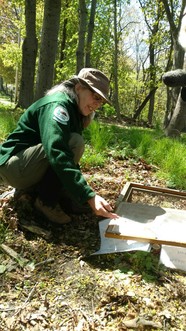 |
|
Winter moth (Operophtera brumata) – On May 21st, 2019 the Maine Forest Service released the fly, Cyzenis albicans, a parasitoid of winter moth, in Bath, Maine. Last fall, 300 Cyzenis pupae were buried in a mesh cage in the ground. When they emerged this spring, we released them into the trees to find and parasitize winter moth caterpillars. This is the first step in establishing this parasitoid in Bath to bring winter moth down to natural levels. The release was attended and documented by Maine’s own Bill Green of “Bill Green’s Maine”. This past year’s release site in Bath was fraught with difficulties, everything from a pine tree falling on the cage to someone opening the cage in early spring to dig through it. This coming June we will be collecting larvae in order to rear them out and collect more fly pupae to do releases in other winter moth-impacted areas in Maine. C. albicans is very host specific and onlyparasitizes winter moth, leaving our native species alone.
Photo: Winter moth predator release in Bath, ME, May 2019.
|
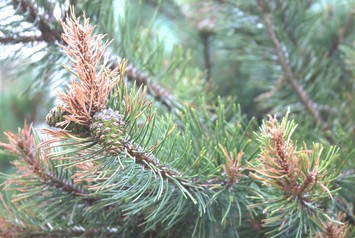
Needle Diseases of Hard Pines – Early spring is the appropriate time to use fungicides to manage several conifer needle pathogens. Diplodia tip blight (Diplodia pinea) of red, Austrian, and Scots pine, and Sirococcus shoot blight (Sirococcus conigenus) of native and exotic species of hard pines are two such diseases. Protection against these perennial problems requires protection of the new, current-season growth with fungicides. A recent diagnosis of Dothistroma needle blight on Austrian pine in Kennebec County is another example of a needle disease that can be controlled with fungicides starting in spring. The potential presence of several diseases in areas serves as a reminder that correct tree species identification and identification of the specific disorder/disease are the first steps to successful management.
Photo: Diplodia tip blight on Mugo pine.
While control of these diseases in plantation settings is challenging and seldom practical once they are established, it is possible to apply fungicide for control in smaller plantings in landscape/yard settings. Generally speaking, the new growth (shoots, expanding needles,) needs to be treated with the appropriate fungicide (e.g. containing the active ingredient chlorothalonil) before infection occurs. This usually requires an application shortly after budbreak, and again ten days to two weeks later, to protect the new growth as susceptible tissues expand (according to the label and depending on the weather and the residual period of activity of the specific fungicide product used). Timing of the first application varies from year to year, depending on local seasonal temperatures. Weekly observations of buds from late April through May will allow customization of fungicide application timing to maximize effectiveness.
|

Spruce Needlecasts – A wet spring season provides ideal conditions for the intensification of Rhizosphaera needlecast (Rhizosphaera kalkhoffii) and Stigmina needlecast (Stigmina lautii) infection on spruce, especially in landscape situations.
Photo: Blue spruce heavily infected by Stigmina needle cast.
The fungal pathogens cause the most significant damage to Colorado blue and white spruces, but other spruce species can be affected. The most frequently and severely affected trees are privacy screen plantings between adjacent properties and windbreak plantings of larger spruce. The tight spacing of these trees impedes air through-flow, keeping foliage wet for longer periods of time, favoring disease. Disease is further favored by cultural practices such as hitting trees with irrigation water and not controlling weeds that grow into the lower canopy – both of these prolong the period of free moisture, favoring infection and disease development. Symptoms typically develop from the bottom interior of the crown and slowly advance in an upward direction, with symptoms decreasing with height (higher portions of the crown dry out faster). Infected older needles turn brown and are shed first. Often, only the tips of the branches retain needles (the last 2 years of growth).
For effective control of Rhizosphaera needle cast, at least two applications of fungicide are required: at half-needle elongation (when new shoots are about 1.5”) and again when needles are fully elongated. For Stigmina needle cast, which begins releasing spores earlier and continues to sporulate later than Rhizosphaera, additional fungicide applications in early spring before budbreak and later in the growing season are needed to manage the disease. Due to the different management approaches, correctly identifying the disease affecting a specific tree is critical to success. It should also be remembered that fungicides are not curative and will only protect against infection of the new, current-season shoots and foliage. Thus, annual treatments over two or three years may be required to fully restore the aesthetics and function of a spruce tree.
|

White Pine Blister Rust (Cronartium ribicola) – Early spring is an ideal time to scout the woodlot for currants and gooseberries (plants in the genus Ribes), which serve as a host for the fungus which causes white pine blister rust. Ribes plants are some of the first vegetation to leaf out in early spring, and thereby easily located for removal or treatment. Due to the late coming of spring in some parts of Maine, there is still time to get out and manage Ribes.
Photo: Orange pustules (aecia) emerging from the base of a white pine tree (Image: W. Kragness).
There are several native species in the genus Ribes common throughout Maine. Cultivated varieties of currants and gooseberries are excellent alternate hosts for white pine blister rust, which is why Maine state law prohibits bringing these plants into Maine and growing them (***see the end of this article for details).
Control of white pine blister rust can be achieved by removing Ribes, since the fungus needs both a Ribes host and a white pine host to complete its complex life cycle and cause disease. Physically removing or treating Ribes plants with herbicide will reduce their numbers and provide control of white pine blister rust. This time of year, it is also possible to scout for the orange pustules that are a sign of the white pine blister rust fungus infecting pine. These structures, called aecia, are typically found at the base of younger white pine trees and at branch junctions/whorls and produce the specialized spores that will infect Ribes leaves. The infected Ribes leaves will produce specialized spores that will re-infect pine later in the summer.
Ribes spp. eradication from nearby white pine stands has been an effective control measure for this disease since the practice was first initiated in Maine around 1918. Removal of all Ribes species within 900 – 1000 feet of susceptible pines or pine stands will greatly reduce the likelihood of infection by the white pine blister rust pathogen. Some other New England states and New York have allowed the cultivation of Ribes specifically bred to be resistant or immune to the disease. However, a more virulent strain of the pathogen was discovered in 2011 in New England, and cultivars of Ribes once resistant or immune are now susceptible, and pose a significant risk of spreading the disease to white pines.
***The importation, possession, planting, and culture of currants, gooseberries, Jostaberries, Worcesterberries and all other species of Ribes is prohibited by law in the quarantine area of Maine. In addition, the importation, possession, planting, and culture of any Ribes nigrum (European black currant) or its varieties or cultivars is prohibited throughout the entire state of Maine.
|
Monday, June 10th, Emerald ash borer talk at 5:30pm at the William Fogg Library, 116 Old Road, Eliot Maine. Speakers include: Oliver Markewicz, district forester, Melissa Brandt, York County Soil and Water Conservation Service and Colleen Teerling, forest entomologist.
For More Information Call (207) 287-2431
Office hours are 7:30 am to 4:00 pm, Monday through Friday, except for holidays. If you plan to visit either office, you may wish to call ahead just to make sure someone will be present to meet with you. (207) 287-2431 (Augusta) and (207) 827-1813 (Old Town)
NOTE: The Augusta office has moved to the Deering Building, 90 Blossom Lane. 50 Hospital Street is no longer open to the public. The mailing address and phone numbers are unchanged. A map is available on our website, https://www.maine.gov/dacf/mfs/forest_health/contact_us.html.
Conditions Report No. 2, 2019
On-line: http://maine.gov/dacf/mfs/publications/condition_reports.html
Department of Agriculture Conservation & Forestry
Maine Forest Service - Forest Health and Monitoring
Contributors: Aaron Bergdahl, Allison Kanoti, Thomas Schmeelk, and Colleen Teerling
|